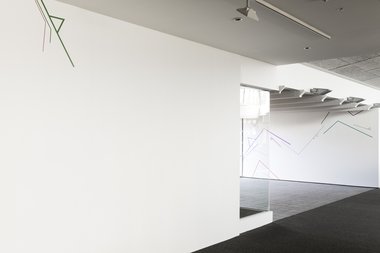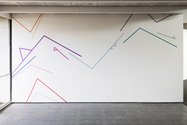John Hurrell – 1 October, 2015
The taped configurations that Novak constructs around architectural features like corners or small bays, usually involve two to four parallel lines aligned at an angle, to which is tangentially added a triangle or rectangle. Different widths of tape are used, with different spacings apart, and different balances of chroma or tone. There are no curves, and usually lines of green, red, purple, orange and blue that sometimes veer off at another angle.
With over a dozen linear configurations made with plastic coloured tape stuck directly onto walls - secreted in little architectural nooks around the ceiling and walls of the multi-purposed Te Tuhi building - Shannon Novak explores visual musicality via geometry and colour as a form of aural codification to make an angular score. Apart from with his use of the Te Tuhi ‘drawing wall’, these are not easy to detect. Tucked into all sorts of unexpected head-high planes, these are often discovered when you walk past and methodically turn back.
The taped configurations that Novak constructs around architectural features like corners or small bays, usually involve two to four parallel lines aligned at an angle, to which is tangentially added a triangle or rectangle. Different widths of tape are used, with different spacings apart, and different balances of chroma or tone. There are no curves, and usually lines of green, red, purple, orange and blue that sometimes veer off at another angle. As a form of musical notation they can be related to chords with say three notes held simultaneously in unison and ascending in volume. The simple geometric shapes can be activities for other instruments on the side, increasing or diminishing in pitch, or moving across a scale.
It may be that Novak experiences a form of synaesthesia when installing these works, but for most people (especially if unassisted by chemical stimulation) the work is about decoding a sign system, and not immediate bodily sensation.
Visually these ‘scores’ look a little like motifs from Art Deco or Streamline Modern, especially when alongside running edges of corners, the triangles and parallel lines being a constantly reoccurring decorative element. However with the large Te Tuhi drawing wall you get the sense that Novak is uninterested in the shape of the rectangular plane as ‘artist’s page’. Placement seems incidental; compositional nuance indifferent; the empty space below the pincerlike enclosing angles unnoticed. It is as if the images plonked themselves down near the top like a flock of birds that just happened to be passing.
This brings with it a sense of the individuality of each splayed configuration, that happens to have others around it but not is affected by them. It is amusing to see such wilful isolation when juxtaposed components deliberately don’t interrelate. Merely items lined up from left to right. Single parts, but no cohesive totality overall.
This view changes, though, if you visually incorporate contextually the rhythms of some of the surrounding architecture, especially parallel elements like horizontally crossing support beams, or vertical ventilation slats, so that as found adjacent components they become parts of the ‘score’ as well - as if within a John Cage composition with Duchampian ‘givens’. An unexpected musical integration of opposed ingredients occurs which - according to the work’s title - strives to be sympathetic. Each location has its own architectural particularities, and some are more successful than others. An interesting experiment.
John Hurrell










 Advertising in this column
Advertising in this column Two Rooms presents a program of residencies and projects
Two Rooms presents a program of residencies and projects



This Discussion has 0 comments.
Comment
Participate
Register to Participate.
Sign in
Sign in to an existing account.